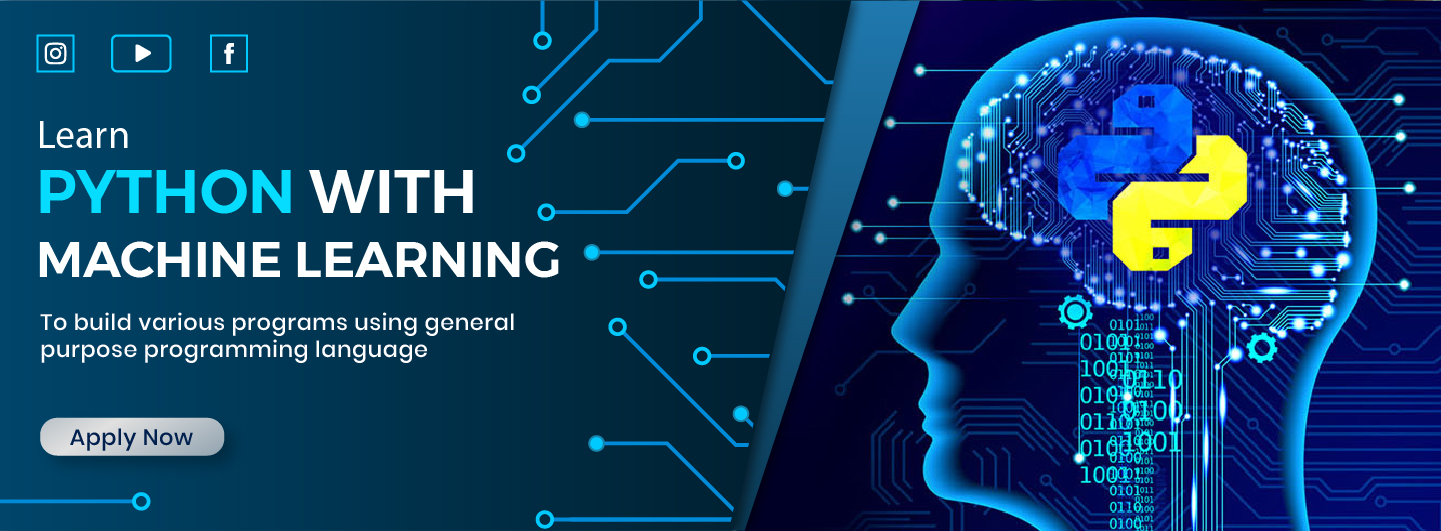


This course provides a comprehensive understanding of Python programming and its applications in Machine Learning. It covers fundamental programming concepts, data structures, object-oriented programming, and essential libraries such as NumPy, Pandas, and Matplotlib. Additionally, the course dives into key Machine Learning algorithms, feature engineering, and data visualization techniques.
Course Highlights
1. |
Python Fundamentals (Variables, Operators, Data Structures) |
2. |
Control Flow and Functions |
3. |
Object-Oriented Programming (OOP) |
4. |
File Handling & Exception Handling |
5. |
Regular Expressions & Modular Programming |
6. |
NumPy & Pandas for Data Manipulation |
7. |
Data Visualization with Matplotlib & Seaborn |
8. |
Exploratory Data Analysis & Feature Engineering |
9. |
Supervised & Unsupervised Machine Learning |
10. |
ML Algorithms: Linear Regression, Decision Trees, Random Forest, SVM, KNN, etc. |
Learning Outcome
| • | Write Python programs using fundamental programming concepts. |
| • | Work with Python data structures and object-oriented programming. |
| • | Utilize NumPy, Pandas, Matplotlib, and Seaborn for data manipulation and visualization. |
| • | Understand machine learning concepts, including supervised and unsupervised learning. |
| • | Implement various machine learning algorithms using Scikit-Learn. |
| • | Perform Exploratory Data Analysis (EDA) and feature engineering. |
| • | Apply machine learning techniques to real-world problems. |
Software and Apps that you will learn in this course




Course Content
Jobs You will Get After Completing Course
Organizations want better personalization, smarter recommendations, and improved search functionality which reduces development time so that programmers can create several Python frameworks and libraries. Python with machine learning is a high-income skill and one of the best expertise that you can have, which will help you make a lot of money, and you can use your creativity as much as you want.
| Job profile After completing this course |
Average salary ( 1+ year experience) |
|---|---|
| Data Scientist | 45k- 65k |
| Data Engineer | 45k- 55k |
| Data Analyst | 35k- 45k |
| Machine Learning Engineer | 45k- 60k |
| Financial Analyst | 30k- 45k |
| Business Analyst | 45k- 55k |

Backup Class

Flexible Timing

Fees Installment

Expert Trainer

100% job assistance

Free Library
.webp)
Live Project
.webp)
Practical learning

Hello,
My name is sarita,I'm student of IFDA institute. IFDA is the best computer training institute. Overall I love all the classes I have taken through IFDA institute,all the instructiors are kind and petient.They are very experienced in the program they are teaching.I have recommended this site to my school and friends. IFDA provides both practical and theoretical classes. Had a great experience here.☺️

I have a great experience in IFDA. The trainers are very supportive and explain every topic in detail. This Institute also provide backup classes on Saturday. I would like to suggest to join IFDA Institute to my friends and relatives. Thank u

I consider it very helpful because when when I first got into IFDA institute, it was very friendly and my knowledge in technology has gotten just not better but best. All the faculty here are very polite and ready to help whenever asked. Getting in this institute was my best decision.

0k +

0k +

0+
.webp)
0+
Frequently Asked Questions
We provide internship and 100% job assistance to those students who are hard-working and well-mannered till the course is completed. We conduct interviews with our recruiters for you to get hired that help you to gain professionalism in this field.
Students can pursue this course if they have completed class 10th from a recognised board and are eager to learn programming and coding skills.
IFDA has emerged as the most encouraging & favorable institute in Delhi which is an ISO-certified computer training institute, started in the year of 2014. We provide various Govt. and Non-Govt. Courses to all the desired students.
Python helps developers to be productive and confident about the software they’re building. Benefits of Python with machine learning include simplicity, consistency, access to great libraries and frameworks for AI and machine learning (ML). This course provides flexibility, platform independence, and a wide community.
With the continued digital transformation, we will be moving slowly to the automated processes and using large amounts of data to make wise decisions. This puts advanced technologies like artificial intelligence (AI), machine learning and in-depth learning. Python has seen impressive growth of about 50 percent in the last year. Even 75% of Netflix users select films recommended to them by the company’s machine learning algorithms which makes this course in demand.
Yes, we provide weekly classes or you can schedule your class according to your suitable time. We also provide online and backup classes so you can attend your missed or pending lectures.
 (1).png)
 (1).png)
 (1).png)
 (1).png)
 (1).png)
 (1).png)
Get free counselling by our experience counsellors. We offer you free demo & trial classes to evaluate your eligibilty for the course.
Have you
Any question
Or need some help?
Please fill out the form below with your enquiry, and we will respond you as soon as possible.